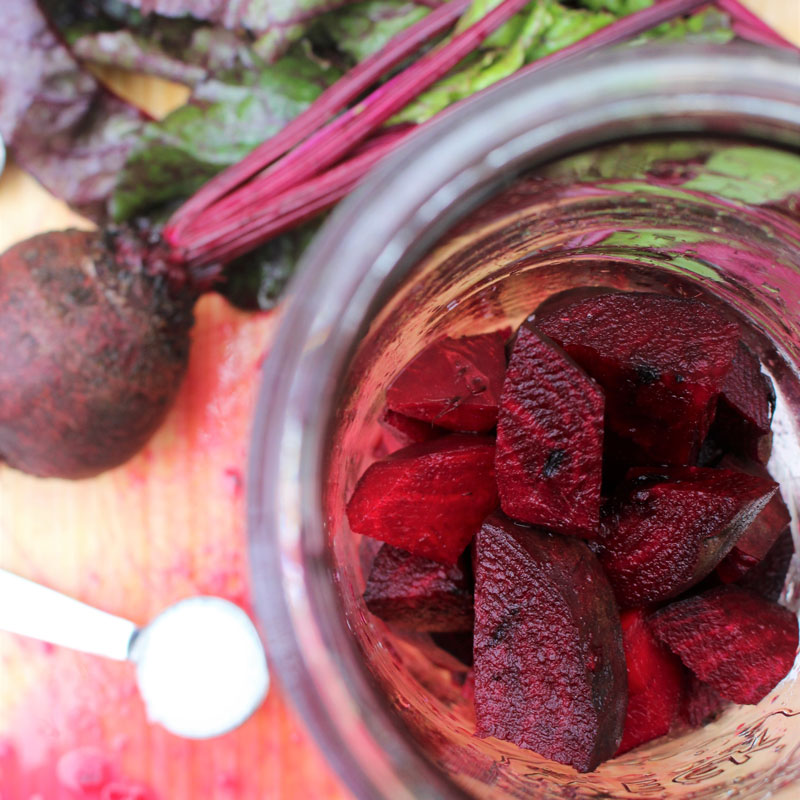
Kvass is best known as being a traditional Russian drink that is made with rye bread. But kvass roots (so the belief goes) date back to Ancient Egyptian times. Beet kvass is a twist on the traditional rye bread beverage, and, with the addition of ginger, it is even more belly-friendly.
Beets are rich in antioxidants, they are known to lower cholesterol levels, and they act as a natural detoxifier. You’ll want to incorporate this easy probiotic drink into your food preservation regimen!
Yield: 1 quart jar
Ingredients
- Three to four small tender beets, cut into 1- to 2-inch chunks, leave skin on
- 2-inch chunk of fresh ginger root (or more for more a potent flavor), skin on, coined
- 1 tsp. coarse kosher salt
- water, as needed
Wash beets, scrub well and trim off ends and greens. Cut into uniform chunks, about 1 to 2-inch square.
Scrub ginger well, cut into coins about 1/2 inches thick. Fill a clean quart jar with beets, ginger and salt (at least half full.)
Fill with cold water, leaving 1 to 2 inches of headspace (top of the water level to the rim of the jar). Stir well.
If you have a small fermentation jar weight, add it to the jar to keep the ingredients completely submerged under the brine. Remove any small pieces of produce that float up to the top of the brine, as produce above the brine will increase the risk of the ferment spoiling.
Wipe off the rim of the jar with a clean, dampened towel. Add the canning jar lid, and tightly screw on the ring.
Read more: Try this recipe for a flavorful fermented radish salsa!
Fermentation
This is a four- to six-day ferment. Ferment at room temperature, ideally between 60-75 degrees F (15-23 degrees C), and keep out of direct sunlight.
Check on the ferment daily to make sure the brine is covering all the produce. If the produce has floated above the brine level, use a clean utensil to push it back below the brine or scoop it out.
Burp the jar daily. Just unscrew the lid briefly and tighten it back on to allow any built-up gas to release. (You’ll avoid possible jar breakage or the ferment from overflowing).
This is an active ferment. Foam-like bubbling after a day or two of fermentation is totally normal and a sign that things are fermenting along just as they should be.
Ferment until the liquid turns to a deep purple. Taste test to determine completion (the flavor should be tangy and earthy). Once done to your liking, transfer to the refrigerator and enjoy within three weeks.
Read more: Beets: You can’t beat ’em!
To Serve
Kvass is best chilled. Drink a small glass between meals, to aid in digestion.
Side notes
If you do not have a glass jar weight, you can improvise by using a small, easily removable, food-grade glass dish that fits inside the jar. Or, if you have a smaller glass canning jar that can fit into the mouth of the jar you are fermenting with, you can use that to keep the produce pushed under the brine.
Don’t like ginger? Leave it out.
If you are unsure if your water is safe for fermentation, you can boil it. Allow water to fully cool to room temperature before adding it to the jar.
After you drink all the kvass, eat leftover beet chunks as-is, blend into a smoothie, or juice or compost them.
This recipe has been adapted from WECK Small-Batch Preserving (2018) with permission from Skyhorse Publishing, Inc.





